The Unabomber's reign of terror lasted for 17 years and sparked the biggest manhunt in FBI history. But what drove Ted Kaczynski to murder?
On April 24, 1995, Gilbert Murray, executive director of the California Forestry Association, received a package. It was about the size and shape of a shoebox and wrapped in brown paper. It was oddly heavy. Stranger still, it was addressed to his predecessor.
The previous executive, William Dennison, had been a vocal lobbyist for the logging industry for a decade and led the charge against environmental groups in what had been called the “Timber Wars.” Whereas Dennison was “contentious,” the 47-year-old Murray was by all accounts mild-mannered and well-liked.

Internet ArchiveThe Unabomber, Ted Kaczynski, in a supermax prison after a 17-year reign of terror. 1999.
A little after 2 p.m., Murray opened the box. A massive explosion ripped through the one-story brick office building, shattering windows and blowing doors off their hinges. Murray was killed instantly, the third fatal victim of the Unabomber, the most wanted individual in the United States. Whoever they were.
For 17 years, someone had been leaving and sending bombs around the country. No one was sure of who they were, their age, where they lived, or even their gender. In all, 24 bombs were sent — some of them fatal.
Ted Kaczynski’s Destruction As The Unabomber
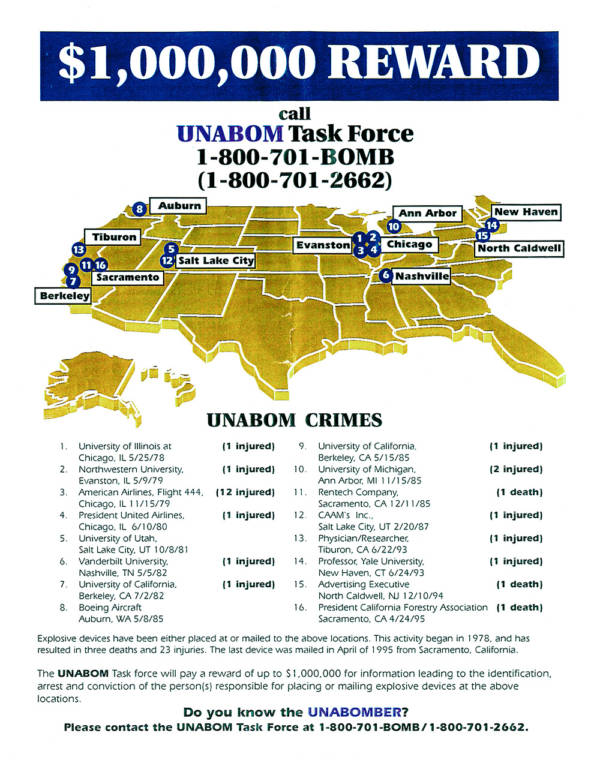
Creative CommonsAn ad for FBI’s UNABOM tip line.
Between 1978 and 1995, the Unabomber terrorized the mail with homemade bombs that killed three people and injured 23 more.
Each device the Unabomber sent out was uniquely constructed. Many of the devices were made of, or with, wood. In most cases, the explosives were made from gun powder, match heads, and other readily available items. One resembled a cigar box and was left in a Northwestern University common area. Another, disguised as a wooden board with protruding nails, appeared in front of a computer store.
Among the earliest and most complicated devices was a package fitted with a barometer for a trigger that would blow up an airplane once it hit cruising altitude. That one didn’t kill anyone, but as the years went by the bomber learned. Each device became more powerful, more concealable, and more deadly than the last.
Because the terrorist sent bombs to universities and an airline, the FBI referred to the case as UNABOM, an acronym for University and Airline Bomber. The news media dubbed them the “Unabomber.”
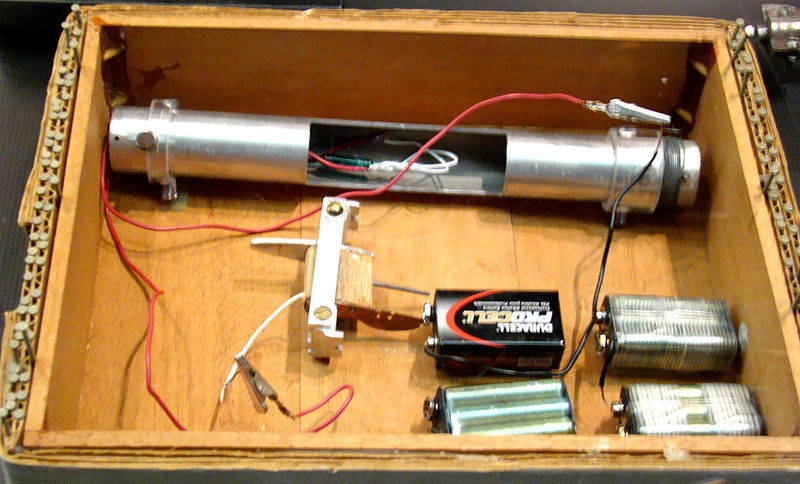
Wikimedia CommonsReproduction of one of Ted Kaczynski, a.k.a. the Unabomber’s, bombs from an exhibit at the Newseum.
The Unabomber meticulously filed away all fingerprints from the bomb parts. Other times, he apparently treated pieces with acid. Any commercial wires used were opened first to modify them by removing strands which rendered them untraceable. Sometimes when sending the bombs, the Unabomber would go so far as to send packages with insufficient postage so that they would be returned to the “sender” written on the box, who was his actual target.
The victims were seemingly random, with attacks in Chicago, California, and New Jersey. They were academics, lobbyists, airline executives, and computer store owners. Many were maimed and lost fingers, limbs, and eyes. Fortunately, apart from Murray, only two others were killed. The only commonalities between the targets seemed to be a tenuous connection to technology or the destruction of the environment.
In all, investigators had few leads. When one early bomb failed to completely explode, they had found some twigs and leaves inside the device. In almost every device, the letters “FC” were welded or carved into one of its surfaces.
The FBI believed they were looking for a blue-collar mechanic or someone good with their hands. A popular theory was that they were a disgruntled former airline employee looking to get back at the big shots. But what investigators would not realize until much later was how close their first discarded guess had come to the truth.
In his initial report from the FBI’s Behavioral Sciences Unit, profiler John Douglas suggested that the terrorist was a white male in his late 20s or early 30s and an “asocial obsessive-compulsive loner of above-average intelligence.” He posited that — since the earliest bombings were at Northwestern University — he was probably from Chicago and had connections to academia.
Douglas’s report proved to be remarkably prophetic, matching Theodore “Ted” Kaczynski Jr. practically to a T.
The Man Behind The Bombs

Kaczynski Family PhotoYoung Ted (left) and brother David Kaczynski with family members.
Born in Chicago in 1942, Ted Kaczynski had, for the most part, a fairly normal middle-class suburban childhood. He had two loving parents and a younger brother, David, who idolized him. He played the trombone and collected coins. He was quiet, sensitive, and shy with others, but he loved animals and being outdoors. He also had an IQ of 167, placing him just above Stephen Hawking and Albert Einstein.
Kaczynski’s mother, Wanda, had grown up in a poor immigrant family in Southern Ohio. For her, education had been a gateway to a better life and she believed the same would hold true for both her sons. When Kaczynski was 15, he graduated early from high school and with his parents’ encouragement applied to and was accepted at Harvard. He started his freshman year at age 16.
But this opportunity would turn out to be a terrible mistake.
During his first year, Ted Kaczynski was quarantined in special housing set aside for the youngest and least mature freshmen. Although the gesture was intended to be a nurturing one, in practice it only encouraged Kaczynski’s introverted nature. He made few, if any, friends and spent most of his time in his room or the library when not in class. Sophomore year was worse.
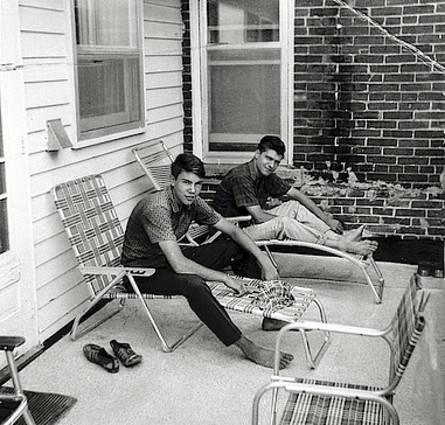
Wikimedia CommonsDavid (left) and Ted Kaczynski in 1967.
That fall, Wanda Kaczynski received a permission slip in the mail. Kaczynski had been accepted into a psychological study for gifted young men, overseen by his professor Dr. Henry Murray. As a minor, however, he could not consent to his own participation. Wanda was enthusiastic. She’d long worried about her son’s mental health and once considered testing him for autism.
At nine months old, “Teddy” had a severe allergic reaction and was stuck in the hospital for a week, poked and prodded away from his parents, and she’d always felt it had affected his relationships with other people. Seven-year-old Kaczynski cried when his brother David was born. He had no friends outside his family and seemed far more comfortable playing with kids his junior than those his own age.
In Kaczynski’s second year at Harvard, his emotional problems got even worse.
Ted Kaczynski Becomes The Unabomber
A former army intelligence officer during World War II, Harvard Psychology Professor Henry Murray completed a psychological profile of Adolph Hitler. In 1947, he returned to Harvard as a chief researcher.
At the time, one of the CIA’s biggest projects — apart from undermining Communist regimes around the world — was an internal one: MKUltra, a study of mind control. Some have alleged that Murray’s Harvard research was part of MKUltra.
As part of this program, Murray and other CIA-funded scientists were — allegedly — tasked with exploring the means of making and breaking an individual’s personality, and developing techniques for brainwashing and mind control including torture, sleep deprivation, and psychedelic drugs, all of which were often used on unsuspecting victims.

FlickrThe Science Center at Harvard University, where Ted Kaczynski studied.
At age 17, Ted Kaczynski signed up to be a test subject in one of Murray’s studies on the effects of stress on the human psyche.
Kaczynski would go to Murray’s lab and after writing essays about his deepest beliefs, values, and ideals, and would debate another student while his vital signs were monitored. Hooked up to electrodes and facing a one-way mirror with bright lights pointed at his face, Kaczynski would debate a law student who was instructed to berate, mock, and belittle everything he held dear.
Murray would record the data of the subject’s anger and embarrassment and then would take the time to show the subject the video recording of their experience and specifically point out their expressions of impotent rage. Kaczynski described it as “the worst experience of my life,” but he stayed in the study for three years. As he later explained, “I wanted to prove I could take it, that I couldn’t be broken.”
After graduation, Ted Kaczynski attended the University of Michigan to pursue a master’s and then a Ph.D. in mathematics. It was here that he started to come undone. He hated his fellow students and his teachers.
In his bedroom, he thought he could hear his neighbors whispering about him. Once, in a manic fit of sexual frustration, he decided the only way he could touch a woman was to become one. He made an appointment with the campus health center to discuss a possible gender reassignment surgery but in the waiting room, he had a change of heart.
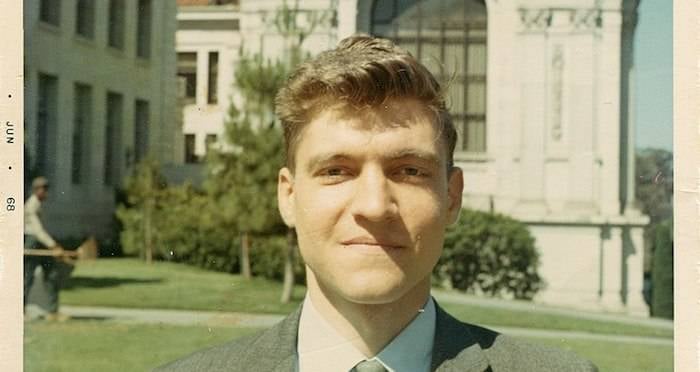
Kaczynski Family PhotoTed Kaczynski at UC Berkeley in 1968.
Embarrassed and angry with himself, his rage shifted to the thought of killing the psychiatrist he was waiting to see. This, he found, made him feel better. He later wrote:
Like a Phoenix, I burst from the ashes of my despair to a glorious new hope. I thought I wanted to kill that psychiatrist because the future looked utterly empty to me. I felt I wouldn’t care if I died. And so I said to myself why not really kill the psychiatrist and anyone else whom I hate. What is important is not the words that ran through my mind but the way I felt about them. What was entirely new was the fact that I really felt I could kill someone. My very hopelessness had liberated me because I no longer cared about death. I no longer cared about consequences and I said to myself that I really could break out of my rut in life and do things that were daring, irresponsible or criminal.
Eventually, he decided, “I will kill but I will make at least some effort to avoid detection so that I can kill again.” But he wouldn’t start just yet.
After completing his doctoral studies, 25-year-old Ted Kaczynski became the youngest-ever mathematics professor at the University of California, Berkeley. But the assessments from most of his students were less than stellar. He did not explain things well. He was too impatient with slow learners. At the end of his second year teaching in 1969, he abruptly quit his job.
Into The Wild
Kaczynski told his family that technological progress would prove disastrous for humanity in the near future, and as such, he could not in good conscience facilitate the process by working as a math professor. His family was cautiously supportive of his views.
David, his younger brother, admired his commitment to his principles. His parents began providing him with an allowance. Secretly his mother worried that her son wasn’t making a stand but rather was “running away from a society he doesn’t know how to relate to.”

Forest Service/FlickrTed Kaczynski lived near the Flathead National Forest in Montana.
Together with his brother, Kaczynski started looking for a rural homestead to call his own. After his application for a Canadian homestead permit was rejected, Kaczynski stayed with his parents for a brief spell and then followed his brother David to Montana. He wanted them to buy some land together.
The brothers settled on a 1.4-acre plot of land outside Lincoln, Montana, an hour or so east of Missoula and not far from the Flathead National Forest. Kaczynski built his own 10-foot by 12-foot, one-room cabin.
The home had no electricity and no running water, though a stream was available for bathing and an outhouse served as the only bathroom. At first, David planned to build a second cabin beside his brother and to live there too, like twin Thoreaus in a Walden-like wilderness.
In short order, however, David realized he didn’t want to live a life “shackled” to his civilization-hating older brother. He took a teaching job in Iowa in 1973.
The Kaczynski family always expected, or rather, hoped that their troubled son would leave the woods eventually and rejoin society. Instead, he was still living in that cabin in 1996 when federal agents arrested him for his crimes.

Kaczynski Family PhotoKaczynski at his cabin in Lincoln, Montana. Circa 1971.
For a few years, Ted Kaczynski truly seemed to hope that solitude would soothe his troubled mind. He dedicated himself to reading, learning survival skills, hunting, identifying edible plants, and even experimenting with crossbreeding new types of carrots. By the end of the decade, however, he could not find solitude anywhere.
Where once there had only been three people living in the entire valley around his home, new houses were erected, and ATVs, motorcycles, snowmobiles and other recreational vehicles became more common. The worst in his opinion, however, were the airplanes and helicopters.
Descent Into Madness
One of the striking things about Kaczynski’s violence was the ways in which his actions were clear outgrowths of his growing rage and paranoia.
When something would upset him, Kaczynski would feel his heart go out of sync and worry his health was failing. Eventually, in 1991, he consulted a doctor in Missoula who determined that he was perfectly healthy and prescribed him some sleep and anti-anxiety medication. Unconvinced, Kaczynski purchased an expensive blood pressure monitor (severely cutting into his $400-a-year budget) to keep track of his own vital signs and sent the physician his results every six months for five years.
Apparently self-aware enough to recognize something was wrong with him, Kaczynski once sought mental health treatment. Reporting his issues with anxiety, he had a single session with a psychiatrist before determining that he could afford neither her fees nor the 60-mile round-trip to her office. After all, his only transport was a bike. He did ask to continue treatment by mail before being informed that this was not how therapy worked.
Then, in July of 1979 — after having already mailed two bombs in the span of a year — having hiked far out into the woods, Kaczynski was relaxing in a hunting camp as far from humankind as he could manage. He heard the sound of airplanes going on for about an hour, followed by what he called a sonic boom. Kaczynski became so enraged and depressed at the interruption that he called off the excursion and returned to his cabin.

The sounds of airplanes and helicopters enraged Ted Kaczynski.
He began trying to shoot passing helicopters and low-flying planes with his hunting rifle, but he never succeeded, and it never helped. He remained so upset by the incident that he kept writing about it in his journal for several months.
“It is not the noise in itself that bothers me, but what that noise signifies,” he wrote, “It is the voice of the Octopus — the octopus that will allow nothing to exist outside the range of its control.” The outdoors had been tainted for him, he said, “I still love it. I suppose it is the same way a mother loves a child who has been crippled and mutilated. It is a love filled with grief.”
Before the Unabomber became national news, residents of Lincoln, Montana noticed something amiss. Recreational cabins near Kaczynski’s own were often broken into. Snowmobiles and motorcycles were damaged or destroyed. Sugar was poured into the gas tanks of the heavy equipment used by local logging and mining operations. Kaczynski’s closest neighbor, Chris Waits, only realized years later that the apparently harmless hermit he considered a friend had probably shot or poisoned several of his dogs.
After Kaczynski’s arrest, Waits further realized the Unabombers’ explosives had been made in large part from items and tools stolen from his own workshop and scrap piles.
At first, Kaczynski kept in touch with his parents and brother semi-regularly while in the cabin, but by the late 1970s, that too had changed. He began to accuse his parents of emotional and verbal abuse and cited their emphasis on his education over all else as central to his persistent problems.
He kept in touch with David until the late 1980s, telling his brother that he was the only person he’d ever loved. But when David married, Kaczynski cut him out too, saying that he wanted nothing to do with his family.
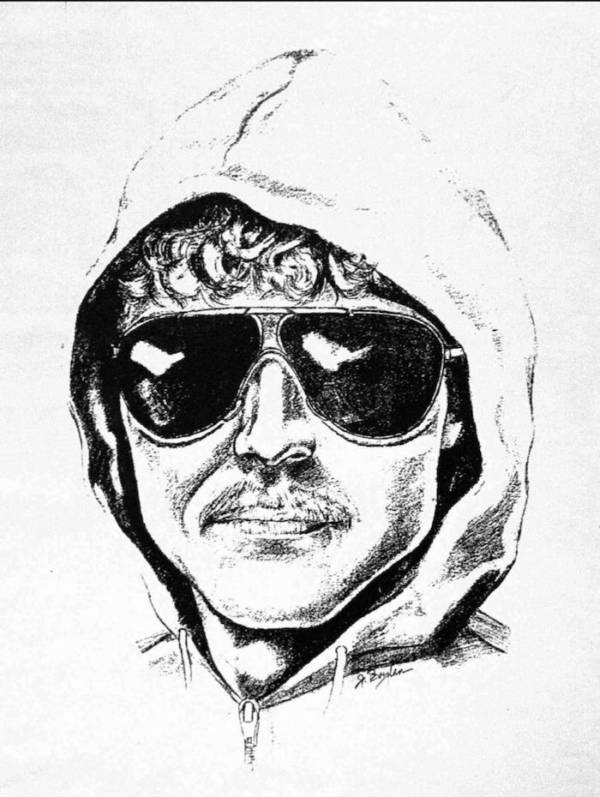
Wikimedia CommonsFBI Composite Sketch of the Unabomber. 1987.
The Manifesto Of The Unabomber
In 1995, not long after the killing of Gilbert Murray, the New York Times and the Washington Post received packages of their own. They contained copies of a 35,000-word, 78-page, typewritten manuscript titled Industrial Society and Its Future.
Included in the package were instructions from the Unabomber; he wrote that if one of the newspapers didn’t publish his manifesto, he would send a bomb to an unspecified location “with intent to kill.” The Attorney General and the Director of the FBI recommended publication in the hopes that, if nothing else, someone might recognize the style of prose.
In the text, Kaczynski tore into what he perceives to be a technocratic superstructure pushed by capitalism, the search of knowledge, and misguided optimism about material progress. Throughout, Kaczynski referred to himself as “we” and spoke on behalf of a so-called “Freedom Club,” which he often abbreviated as “FC” in his letter bombs.
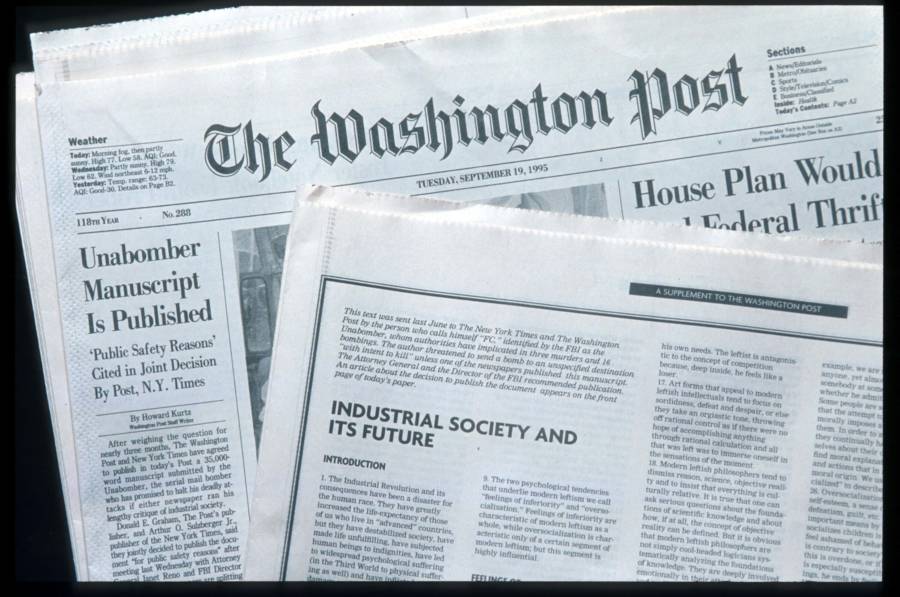
Evan Agostini/LiaisonThe Washington Post printed the Unabomber’s manifesto on Sept. 19, 1995 at the request of Attorney General Janet Reno and the FBI.
He pointed to the automobile — once a luxury and now a necessity — to argue that “advancement” eroded personal freedom and created new norms that individuals had to adopt in order to remain in society. He argued that “progress” in the political, economic, and media structures, would destroy individuality and ecological stability. He attacked “leftism” and the push for “social reforms.”
He questioned the ability of even well-meaning individuals to resist the negative consequences of technology. He accused moralistic media of being propaganda that blinded people to the reality of their own motives. The only solution to such a dystopia, the Unabomber concluded, was violent resistance.
Before Industrial Society and Its Future‘s publication, the media reported that the Times and the Post had received a manifesto from the Unabomber railing against modern technology. In the late summer of 1995 at their home in Schenectady, New York, Linda Patrik, David Kaczynski’s wife, asked her husband, “Has it ever occurred to you, even as a remote possibility, that your brother might be the Unabomber?”
Searching For The Unabomber: The Biggest Manhunt In FBI History
David Kaczynski was taken aback. His wife had never even met his reclusive sibling. How could she accuse him of terrorism? But his wife pointed out the fixation on technology and its impact on society as the same things that his brother was obsessed with, the same beliefs she’d heard David and his mother attempt to understand at countless worried family meetings.
Ted Kaczynski was disturbed, David knew, but he wasn’t violent. He couldn’t be the Unabomber. Still, if only to change the subject, he promised to read the manifesto when it was released.
A few days later, after reading Industrial Society and Its Future, David was unconvinced. His brother had never been particularly political, even at Berkeley. For all his love of nature, he wasn’t even much of an environmentalist. At the end of his first reading, David first concluded that there was “maybe one chance in a thousand that Ted might have written it.”
But his wife remarked that one in one thousand was still too close for comfort. Reluctantly, David agreed.
Over the next few months, the couple pored over the manifesto and compared it to the letters Kaczynski had sent his brother before their falling out. Finally, David acknowledged, there was a “50-50” chance his brother was the Unabomber. At that point, they called the FBI.
Despite being the longest and most expensive investigation in FBI history, by the early 1990s, the FBI was at this point no closer to catching Kaczynski than they had been when the bombings started in 1978.
In 1987, a witness had briefly caught a glimpse of the Unabomber dropping off one of his bombs at a Salt Lake City parking lot and provided the FBI with a description. Unfortunately, she had seen Kaczynski from across a parking lot and he had been wearing sunglasses and a hooded sweatshirt. He had also shaved his beard down to a mustache.
Kaczynski was meticulous in his efforts to avoid capture. He rarely went into public without a disguise. He even planted false evidence — like a couple of hairs he’d picked up at a bus station — in one device’s electrical tape. But, in the end, what would give Kaczynski away was his ego.
Ted Kaczynski’s Capture
On April 3, 1996, Ted Kaczynski was sitting in his cabin with a loaded gun near his side when a voice from outside called. The Forest Service wanted to talk to him about the border of his property line, a topic Kaczynski was eager to angrily discuss. As he walked out the door, a pair of federal agents immediately arrested him. This was more fortunate than they could have known.
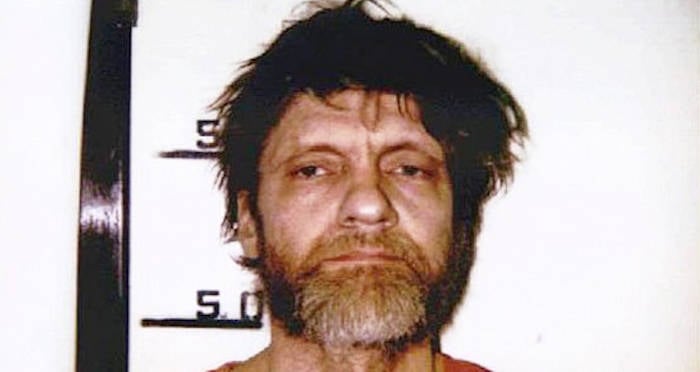
Wikimedia CommonsTed Kaczynski’s booking photograph in 1996.
Attached to a string beside Kaczynski’s bed, there was an incendiary device designed to set his cabin on fire, in turn destroying all his journals and other evidence. He’d planned to grab his gun and run, if ever cornered, north through the dense forest, recovering stashes of food, ammunition, and other supplies he had buried in hiding places he memorized until he made it into Canada.
Although it was not part of his escape plan, the enormous amount of evidence was not the only thing spared from the flames. Underneath Kaczynski’s bed, there was another bomb, ready to mail, which would have detonated in the conflagration.
Along with this bomb were books on anthropology, history, metallurgy, and chemistry. Investigators found jars of bomb-making equipment, a typewriter, and the original copy of Industrial Society and Its Future. They also found 30,000 pages of diary entries dating back to the early 1970s written in English, Spanish, and other parts in a code.
Cryptographers were impressed by the complexity of Kaczynski’s cipher which was made all the more difficult to decrypt by his use of intentional misspellings, lack of apostrophes, and random use of spacing.
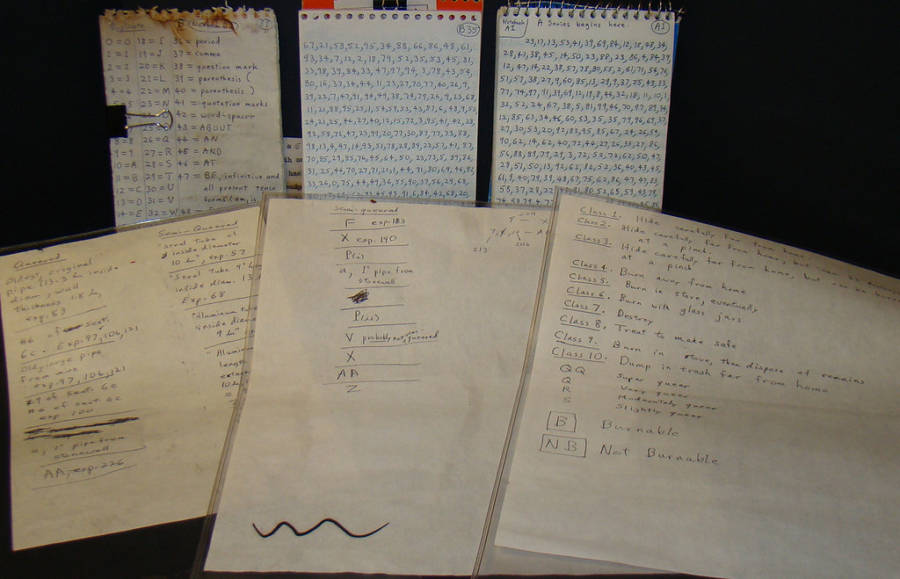
US Marshals ServiceThe Unabomber’s coded journals.
The code was so complicated, in fact, that Kaczynski could not remember it on his own. As a result, along with his other writings and journals, investigators found the solution key to the code which then gave them access to what amounted to the Unabomber’s decades-long confession.
A Tricky Trial
Although Kaczynski was in custody and the FBI had enough evidence to take the case forward, they had not planned on the difficulties this trial would present.
Kaczynski’s defense attorneys, against his wishes, prepared a convincing insanity defense. Their key piece of evidence would be Kaczynski’s cabin and argued that no sane person would willingly spend 25 years in the brutal Montana winters in such a small and rudimentary structure.
To sell their case to the jury, the defense planned to have the cabin transported to the court for jurors to walk through so that they could appreciate just how awful and uncomfortable the Unabomber’s lifestyle must have been. This presented the prosecution with a problem: they hoped to pursue the death penalty, an impossibility if Kaczynski was declared insane.

Ted Kaczynski’s mailbox in Lincoln, Montana.
Sane Or Schizophrenic?
The trial opened on January 8, 1998. But, despite nationwide anticipation, it never really started.
Angered by the insanity plea plan, Kaczynski tried to fire his defense team. Although this meant risking the death penalty, that mattered less to Kaczynski than preserving his name. If society labeled him crazy, it meant his ideas and his manifesto could be ignored. So long as he was officially sane, he reasoned, it would be harder to dismiss his arguments, a goal so important to him he requested to serve as his own attorney. He was denied.
On Jan. 16, Dr. Sally C. Johnson, the prosecution’s psychology expert, wrote her report on Ted Kaczynski’s mental state after speaking with him for 22 hours. Although she determined that he was coherent and mentally fit to stand trial, she also concluded that his obsession with purported parental abuse and technology were delusional beliefs consistent with paranoid schizophrenia.
Further, given that he was in his early to mid-20s when his delusions started, which is also the same age that most schizophrenics begin to experience symptoms, it seemed likely that Kaczynski was in fact deeply mentally ill.
Knowing that they could not secure the death penalty, the state offered Kaczynski a plea deal. In exchange for a guilty plea, he would avoid the death penalty and the declaration of insanity. Kaczynski agreed, and on Jan. 22, 1998, he pled guilty to 13 charges. He was given eight life sentences without the possibility of parole.
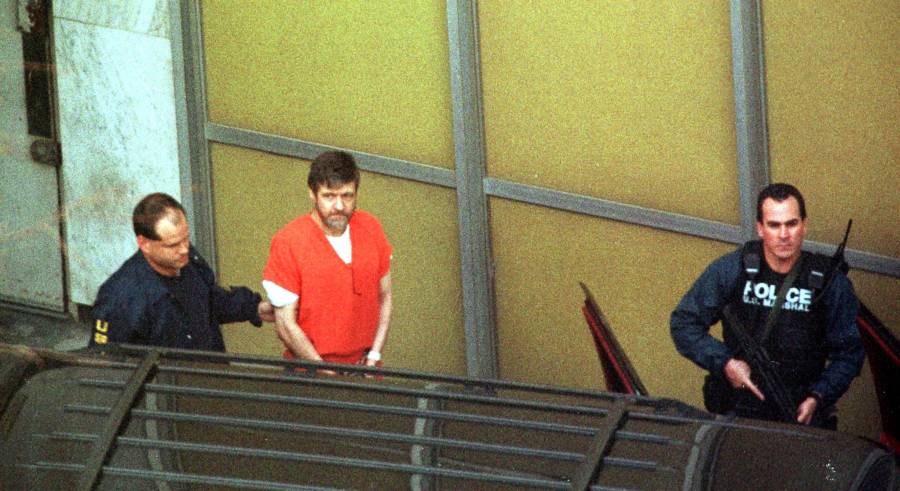
Bob Galbraith/AFP/Getty ImagesTheodore Kaczynski is lead out by armed US marshals at the Federal Courthouse.
For the last 21 years, Ted Kaczynski has been incarcerated at ADX Florence in Colorado, a.k.a. “The Alcatraz of the Rockies.”
He maintains a steady correspondence with the curious and with admirers, and has, to date, published two books from prison including the 2010 anthology Technological Slavery with a professor from the University of Michigan-Dearborn.
Although surrounded by the Rocky Mountains, Ted Kaczynski never sees them as his few glimpses of nature come only through a skylight in his cell. Apparently, he does not mind the solitude.
Ironically, Ted Kaczynski’s former home has more than its fair share of visitors. The infamous “Unabomber Cabin,” built as an escape from society, was sold at an auction in 2006. Today, it resides at the Newseum in Washington D.C. where it is one of the most popular features of the “Inside Today’s FBI” exhibit.
If you enjoyed reading about Ted Kaczynski, a.k.a. the Unabomber, then learn more about his brother, David Kaczynski. Then, for more on the FBI’s 17-year investigation, check out James Fitzgerald, the man who eventually brought the Unabomber’s 18-year terror streak to an end.





